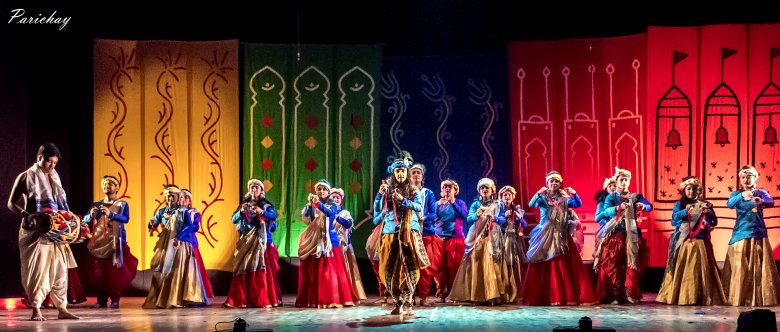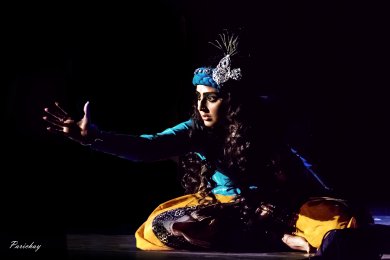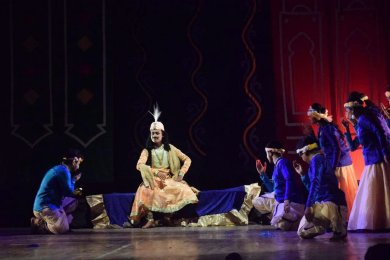
|   |

|   |
Alokparna Guha's 'Ehi Kesava' -Tapati Chowdurie e-mail: tapatichow@yahoo.co.in July 16, 2018 The first half of Kathaka Alokparna Guha's 'Ehi Kesava' performed at Satyajit Ray auditorium of ICCR, Kolkata, delved into the journey of Kathak, which she merged seamlessly into the concluding half, which dealt with the last days of the life of Krishna as a human being. He reminisces about his past and his many adventures, in the socio-political context within the periphery of theatre.  Alokparna and disciples Alokparna Guha led the audience on a history lesson to trace the gradual changes that made Kathak develop and grow to what it is today. It was a tale full of interesting bends and twists told by a vibrant group of energetic and committed dancers. The choreographic work of this piece through dance and drama using all the abhinayas as delineated in the Natya Shastra such as the angika, vachika, aharya and satvika, held audience attention till the very end. The story of the Kathaka is the story of a performer cum entertainer who tried to please the listeners for a living, finally finding its pride of place in temples, singing and dancing to the glory of god. Kathak came to be patronized by temples. With the establishment of the Delhi Sultanate, Nritya Geet was stopped, temples were reduced to shambles and the Kathaka had to leave the sinking boat, because times had changed. Through dance dialogue it was dramatized to say that, "Kathak remained the same. The only significant thing that happened was that instead of bowing to the deity in obeisance, the dancer had to salaam to the reigning king." With the Sultan as the patron, Kathak's character had to be changed for the survival of the practitioners of the form. Bol, gati and the other nuances of Kathak that was invented as a necessity was shown, along with gat nikas, pharmayishi, paran and the rest that were innovated. At this stage the technique of Kathak took precedence over mythological themes. It was a gripping tale made interesting by a creative presentation. Alokparna Guha in the role of the Sutradhar introduced the next phase of the story that happened with the coming of the Mughals. Muhammad Akbar was an avid art lover and in his darbar every evening, he had Kathakas entertain him and his court by using them as chess coins. At this time, the creation of aamad, paran, tukra, tihai, lari ki keramati' took a long stride in development of Kathak in equipping performers to dazzle the vision of the Mughal Samrat. The group ably displayed these aspects. Dramatization of the Lucknow Nawab Wajid Ali Shah's love for Kathak brought in a sea of development in the style. Alokparna spoke of the change in the genre at the time of the Nawab. I quote from her production: "Badal gayi dhara, nawab badal gaya, badla Kathak ki nazaria" -the Kathak style was changed in its expressions under Nawab Wajid Ali Shah. The nuances of bhava were introduced with his poetic sensibilities. Thumris were introduced in dance. The poet in the Badshah poured out, "Darasa bina mohe kal nahi aye, Kya karun Sakhi.... Sudh budh bisara gaye re." Lucknow city became the repository of sur and ras. The joy of dance was found in the intricate sense of laya created in several speeds in myriads of sounds of the tatkar. In the nooks and corners of Lucknow, swaras were given life. He composed lyrics to which Kathak was practiced. "Hindola jhule shyam, jug jug jiyu sada birajo, Jane alam mubaraka." The frightening impact of the marching into Lucknow of the British soldiers was ominous. Badshah Wajid Ali however did not bow down to their threats. So he was forcefully banished from his beloved Lucknow to Metiabruz, which is presently in Kolkata and Kolkata became the centre of artistic activities in both dance and music as well as the mouth watering Lucknow cuisine.  Alokparna as Krishna  Wajid Ali Shah "Lucknow se ja rahe hai Nawab" was the heart rending wail of the people of Lucknow. Wajid Ali Shah was thus deported, but his Kathak could not be taken away. Kathak still reigned supreme in the people's heart. There were visionaries, who gave their lives for Kathak. The same bols, same gati, same everything were practiced. It could not be wiped away from the minds of Kathak lovers. This fact vigorous Kathak movements. Costumes were imaginatively planned. Then what followed was 'Ehi Kesava.' When end neared his mortal existence, Krishna looked back at Vrindavan. He became emotional in the final days of his life. This part of the story was not on Krishna the god, but Krishna the human being, the wily one that stole butter from his mother's pot with his accomplices, incurring the fake anger of mother Yasoda. "Makhon chori maiya boli" was chanted and enacted with a lot of laughter. Melodious playing of the flute in Vrindavan and many other activities haunt him on his death bed. He is reminded of how serpent Kaliya's presence in Yamuna had contaminated its water and it was only his intervention that caused his flight. The gopis remind him how he had done so. Krishna's plunge into the river and the subsequent dramatic fierce fight had a cathartic effect. Vigorous and dynamic group dancing ended with Krishna saying, "Mera Vrindavan Kesava ka Vrindavan". Vrindavan had submerged in water due to torrential rains and required his intervention. He then lifted Mount Govardhan to prevent the place from drowning. In the face of arrogance, Krishna's lack of ego ruled. Becoming emotional, he asked his devotees to call him Kanha, Kesava and Murari. The music of the greatest flautist brought in joy. He is "Gopal Govinda Yashomati Nandana natabara nagara." The presentation ended with the chant "Radhe Shyam, Radhe Shyam, Shyam Shyam Radhe Radhe, Radhe Krishna Radhe Krishna, Krishna Krishna Radhe Radhe." Tapati Chowdurie trained under Guru Gopinath in Madras and was briefly with International Centre for Kathakali in New Delhi. Presently, she is a freelance writer on the performing arts. |